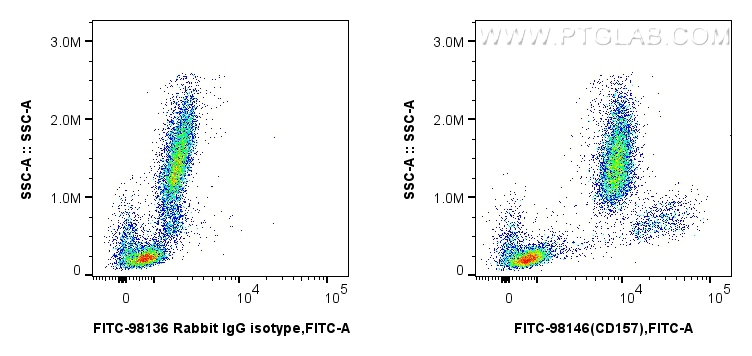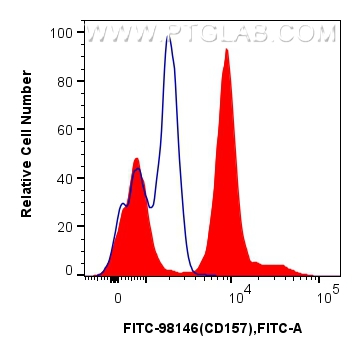验证数据展示
经过测试的应用
| Positive FC detected in | human peripheral blood leukocytes |
推荐稀释比
| 应用 | 推荐稀释比 |
|---|---|
| This reagent has been pre-titrated and tested for flow cytometric analysis. The suggested use of this reagent is 5 ul per 10^6 cells in a 100 µl suspension or 5 ul per 100 µl of whole blood. | |
| Sample-dependent, Check data in validation data gallery. | |
产品信息
FITC-98146 targets CD157 in FC applications and shows reactivity with human samples.
| 经测试应用 | FC Application Description |
| 经测试反应性 | human |
| 免疫原 | Recombinant Protein 种属同源性预测 |
| 宿主/亚型 | Rabbit / IgG |
| 抗体类别 | Recombinant |
| 产品类型 | Antibody |
| 全称 | bone marrow stromal cell antigen 1 |
| 别名 | BST 1, Bone marrow stromal antigen 1, ADP-ribosyl cyclase/cyclic ADP-ribose hydrolase 2, ADP-ribosyl cyclase 2, ADP ribosyl cyclase 2 |
| 计算分子量 | 318 aa, 36 kDa |
| GenBank蛋白编号 | BC012095 |
| 基因名称 | CD157 |
| Gene ID (NCBI) | 683 |
| 偶联类型 | FITC Plus Fluorescent Dye |
| 最大激发/发射波长 | 495 nm / 524 nm |
| 形式 | Liquid |
| 纯化方式 | Protein A purification |
| UNIPROT ID | Q10588 |
| 储存缓冲液 | PBS with 0.09% sodium azide and 0.5% BSA , pH 7.3 |
| 储存条件 | Store at 2-8°C. Avoid exposure to light. Stable for one year after shipment. |
背景介绍
CD157, also known as bone marrow stromal cell antigen 1 (BST-1), or ADP-ribosyl cyclase 2, is a glycosyl phosphotidylinositol-anchored protein that stimulates pre-B-cell growth and has adenosine diphosphate (ADP)-ribosyl cyclase and cyclic ADP-ribose (cADPR) hydrolase activity (PMID: 9473467, 11866528). The two enzymatic activities are responsible for the synthesis and hydrolysis of cADPR, a novel second messenger of calcium release from intracellular calcium stores.
实验方案
| Product Specific Protocols | |
|---|---|
| FC protocol for FITC Plus CD157 antibody FITC-98146 | Download protocol |
| Standard Protocols | |
|---|---|
| Click here to view our Standard Protocols |

